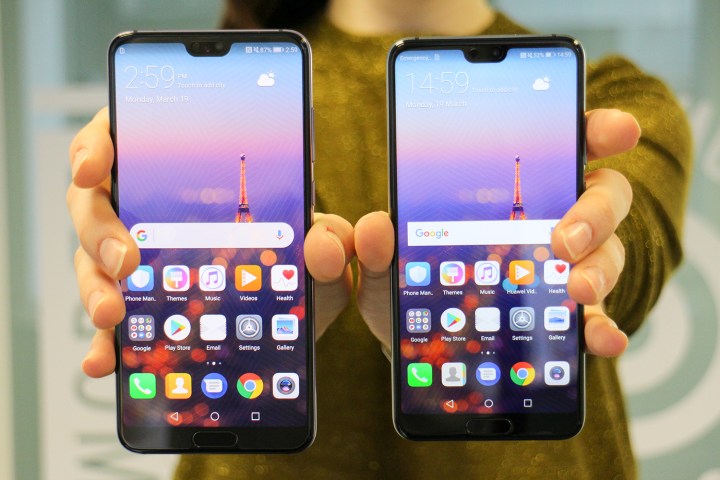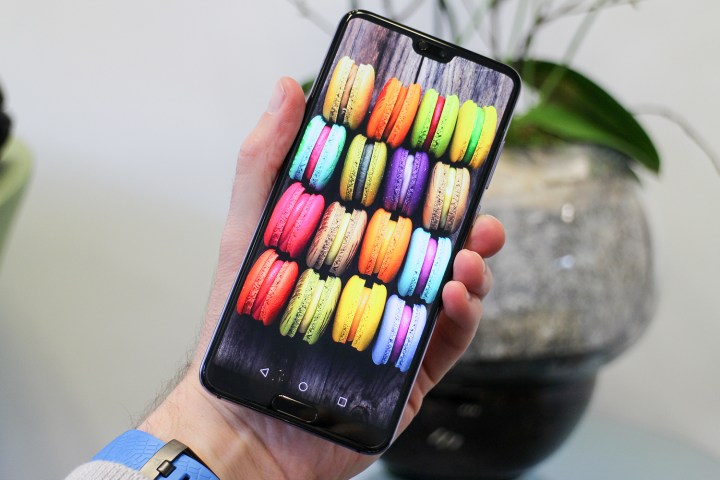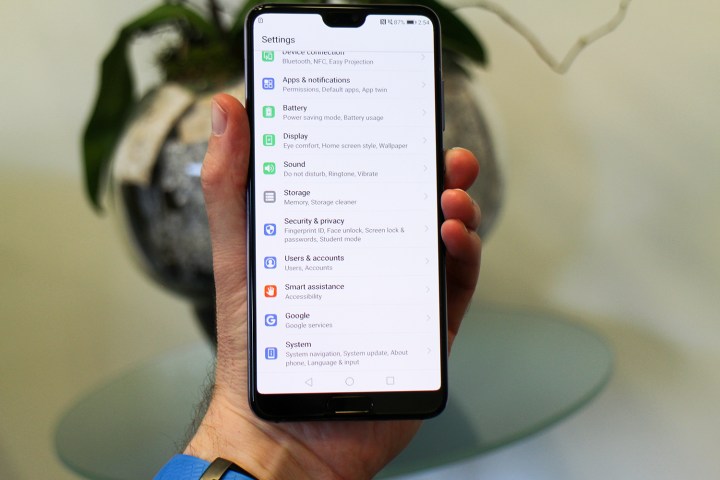The fact that Huawei has repeatedly run into issues trying to break into the U.S. market hasn’t stopped the Chinese manufacturer from turning out some very impressive Android smartphones. The Huawei P20 and P20 Pro offer a compelling combination of cutting-edge hardware and software, but there are some big differences between the two. If you’re considering buying one of them, then this comparison will help you get a grasp on where they’re similar and where they diverge.
Specs
| Huawei P20 Pro | Huawei P20 | |
| Size | 155 x 73.9 x 7.8 mm (6.1 x 2.9 x 0.3 inches) | 149.1 x 70.8 x 7.65 mm (5.87 x 2.78 x 0.3 inches) |
| Weight | 174 grams (6.14 ounces) | 165 grams (5.82 ounces) |
| Screen size | 6.1-inch OLED display | 5.8-inch LCD display |
| Screen resolution | 2,240 x 1,080 pixels (408 pixels-per-inch) | 2,240 x 1,080 pixels (428 pixels-per-inch) |
| Operating system | Emotion UI 8.1 (over Android 8.1 Oreo) | Emotion UI 8.1 (over Android 8.1 Oreo) |
| Storage space | 128GB | 128GB |
| MicroSD card slot | No | No |
| Tap-to-pay services | Google Pay | Google Pay |
| Processor | Kirin 970 | Kirin 970 |
| RAM | 6GB | 4GB |
| Camera | Triple lens 40MP, 20MP, & 8MP rear, 24MP front | Dual lens 20MP & 12MP, 24MP front |
| Video | 2160p at 30 frames per second, 1080p at 30fps, 720p at 960fps | 2160p at 30 frames per second, 1080p at 30fps, 720p at 960fps |
| Bluetoothversion | Bluetooth 4.2 | Bluetooth 4.2 |
| Ports | USB-C | USB-C |
| Fingerprint sensor | Yes | Yes |
| Water resistance | IP67 | IP53 |
| Battery | 4,000mAh | 3,400mAh |
| App marketplace | Google Play Store | Google Play Store |
| Network support | T-Mobile, AT&T | T-Mobile, AT&T |
| Colors | Black, Blue, Pink Gold, Twilight | Black, Blue, Pink Gold, Twilight |
| Price | 899 euros (around $1,100) | 649 euros (around $800) |
| Where to buy it | Huawei | Huawei |
| Review score | Hands-on review | Hands-on review |
Performance, battery life and charging
Dissect either of these phones and you’re going to find Huawei’s own Kirin 970 processor inside, along with its special Neural Processing Unit (NPU), which is designed to offer all kinds of artificial intelligence (A.I.) enhancements without slowing things down or draining too much power. You get 6GB of RAM in the P20 Pro, while the P20 makes do with 4GB of RAM. Only serious multitaskers will feel the difference. Both phones have 128GB of storage, but there’s no MicroSD card slot.
It’s easier to separate these phones on battery life because the P20 Pro has a 4,000mAh battery, while the battery in the P20 is only rated at 3,400mAh. The P20 Pro has a marginally bigger screen and a few more tricks up its sleeve, but we can’t see that being enough to cancel out the extra capacity, so we expect the P20 Pro to have more stamina than its sibling. There’s no wireless charging here, but you can expect both phones to support Huawei’s SuperCharge fast-charging standard.
Winner: Huawei P20 Pro
Design and durability
The all-glass, curved design of these phones is extremely attractive and they come in some interesting finishes, particularly the twilight option, which shifts from purple to teal. Strangely, Huawei has put the fingerprint sensors on the front, in the old traditional spot beneath the screen, but the main thing that jumps out is that notch at the top. We’re not keen on the notch trend afflicting Android phones right now, but if you’re going to do it, there’s nothing wrong with Huawei’s implementation — the notch in the P20 and P20 Pro is much smaller than the iPhone X’s notch.
There’s nothing to divide these phones on the design front, but if we delve into durability, the P20 Pro is clearly superior. The P20 has a distinctly disappointing IP53 rating, while the P20 Pro scores an IP67 rating. In simple terms, this means that the P20 Pro can survive submersion, but the P20 probably won’t.
Winner: Huawei P20 Pro
Display
The Huawei P20 sports a 5.8-inch RGBW LCD screen, while the P20 Pro boasts a 6.1-inch OLED screen. Both of them have a 2,240 x 1,080 pixel screen resolution. Strictly speaking, this makes the P20 screen a touch sharper, but the P20 Pro has a much higher contrast ratio, with rich colors and really deep blacks.
Winner: Huawei P20 Pro
Camera
The camera war in smartphones has reached new heights recently, as the battle for supremacy has spilled beyond megapixel count and led many manufacturers to adopt secondary lenses. Huawei is taking things a lot further with the P20 Pro by packing in three lenses: There’s a 40-megapixel main lens with A.I. Image Stabilization (AIS), a secondary telephoto lens rated at 8-megapixels, and a third 20-megapixel monochrome lens. This camera offers 3x optical zoom, which can be enhanced digitally to 5x. It also delivers incredible detail and solid low -light performance.
By contrast, the P20 combines a 12-megapixel primary lens with a 20-megapixel monochromatic lens. It may not have as many tricks at its disposal, but we still expect it to be a good performer. Both phones have front-facing cameras rated at 24-megapixels, which should be enough to elevate your selfie game to the next level.
Winner: Huawei P20 Pro
Software and updates
You’ll find the latest Android 8.1 Oreo on the P20 and P20 Pro, with Huawei’s EMUI 8.1 user interface on top. It’s quite a departure from stock Android, and it means you won’t get the latest software updates as soon as Google rolls them out. Huawei’s software is packed with clever A.I. tricks, enabling things like keyword search in the photo gallery app. There’s no real difference between the two phones in this category.
Winner: Tie
Special features
Huawei is firmly focused on the triple-lens camera as the standout feature of the P20 Pro, but everything else you might point to as a special feature can be found on both phones. There is a face unlock option on the P20 and P20 Pro that uses 2-D mapping to authenticate users in only half a second, but it’s not as secure as the iPhone X’s Face ID, so you can’t use it for payments.
Winner: Tie
Price
This has been a very one-sided battle so far, but the P20 is able to score a win on price, because it’s significantly cheaper than the P20 Pro. The Huawei P20 costs 649 euros (around $800), while the P20 Pro costs 899 euros (around $1,100).
The phones are available globally now. The bad news is that the P20 and P20 Pro will not be released through carriers in the U.S. after they were pressured to drop Huawei phones by Republican politicians, due to security concerns.
Winner: Huawei P20
Overall winner: Huawei P20 Pro
There is absolutely no doubt that — as the name would suggest — the Huawei P20 Pro is a better phone than the P20. It has that triple-lens camera, a superior display, a bigger battery, and it’s more durable. The P20 is still a decent device, offering the same level of performance, A.I. smarts, and gorgeous design, but it falls well short of the P20 Pro. All you really have to decide is whether you can stretch your budget.









